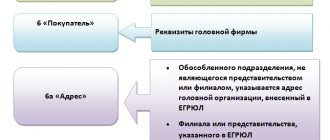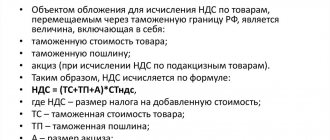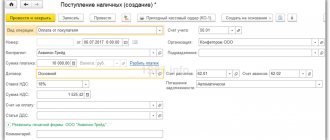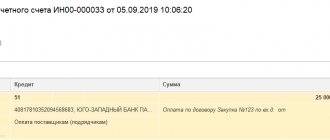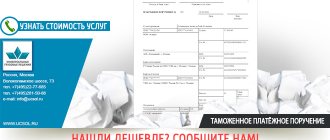Mandatory invoice details
Mandatory invoice details are determined by several paragraphs of Art. 169 Tax Code of the Russian Federation:
- item 5 - for registration of sales;
- clause 5.1 - for received advances;
- clause 5.2 - to make adjustments to sales data related to changes in volume or price and entailing a change in the total cost of sales and, accordingly, the amount of accrued VAT;
- clause 6 - for document signatures.
What has changed in invoices recently?
From 07/01/2021 a new invoice form is in effect, incl. adjustment, as amended by the Decree of the Government of the Russian Federation dated 04/02/2021 No. 534. The update of the form was caused by the introduction of a goods traceability system. All taxpayers are required to use the new form, even if the goods are not included in the traceability system. We described in more detail the changes made to the invoice here.
You can download the new invoice form by clicking on the image below:
ConsultantPlus experts have prepared step-by-step instructions, explaining the procedure for filling out an invoice line by line. If you don't have access to the system yet, get a trial demo access for free.
The form of the adjustment invoice has also changed. You can download the updated form from the link below.
From 2022, they reflect the new VAT rate of 20%. This important change did not directly affect the form of the document, since the rate is not included in the form, but is added to the document when it is filled out. The form itself was adjusted in 2017, and this happened twice.
Read more about the changes here.
So, in paragraphs. 5, 5.1, 5.2 art. 169 of the Tax Code of the Russian Federation, Law dated April 3, 2017 No. 56-FZ, introduced additional subparagraphs, according to which another additional detail was introduced into invoices: “Identifier of the state contract, agreement (agreement) (if any).” This detail has become mandatory since 07/01/2017 and must be filled in if a sales invoice, advance or adjustment is issued under a government contract. The detail “Identifier of the state contract, agreement (agreement) (if any)” was introduced into the invoice form by Decree of the Government of the Russian Federation dated May 25, 2017 No. 625.
Since July 2016, the required invoice details include the code of the type of goods when exported to member countries of the EAEU (subparagraph “b”, paragraph 2 of the law dated May 30, 2016 No. 150-FZ, subparagraph 15, paragraph 5 of Art. 169 of the Tax Code of the Russian Federation). However, until October 1, 2017, the invoice form did not contain such mandatory details and sellers when exporting to EAEU member countries had to indicate information about the code of the type of goods in additional lines and columns (letter of the Ministry of Finance of Russia dated November 14, 2016 No. 03-07-09 /66475). By Decree of the Government of the Russian Federation dated August 19, 2017 No. 981, the invoice form was supplemented with this detail. Based on the indicated articles of the Tax Code of the Russian Federation, two forms of invoices have been developed in Decree of the Government of the Russian Federation dated December 26, 2011 No. 1137:
- The main one (Appendix 1), which is used when processing shipments, receiving advances and correcting technical errors in these documents.
- Adjustment (Appendix 2), which is issued when the volume or sales price changes. It contains additional lines to reflect differences arising in the cost of the goods and the amount of tax related to it.
From 10/01/2017 to 06/30/2021 invoice form, incl. corrective, acted in a different edition. You can download the forms from our website using the link below:
See also article.
Filling out the invoice
The concept of “invoice” is given in Article 169 of Chapter 21 “Value Added Tax” of the Tax Code of the Russian Federation: 1. An invoice is a document that serves as the basis for accepting the presented tax amounts for deduction or reimbursement in the manner prescribed by this chapter.
2. Invoices drawn up and issued in violation of the procedure established by paragraphs 5 and 6 of this article cannot be the basis for accepting tax amounts presented to the buyer by the seller for deduction or reimbursement. Failure to comply with the requirements for the invoice, not provided for in paragraphs 5 and 6 of this article, cannot be grounds for refusal to accept for deduction the tax amounts presented by the seller.
3. The taxpayer is obliged to draw up an invoice, keep logs of received and issued invoices, purchase books and sales books, unless otherwise provided by paragraph 4 of this article:
1) when performing transactions recognized as an object of taxation in accordance with this chapter, including those not subject to taxation (exempt from taxation) in accordance with Article 149 of this Code;
2) in other cases determined in accordance with the established procedure.
4. Invoices are not drawn up by taxpayers for transactions involving the sale of securities (except for brokerage and intermediary services), as well as by banks, insurance organizations and non-state pension funds for transactions that are not subject to taxation (exempt from taxation) in accordance with Article 149 of this Code .
5. The invoice must indicate:
1) serial number and date of issue of the invoice;
2) name, address and identification numbers of the taxpayer and buyer;
3) name and address of the shipper and consignee;
4) the number of the payment and settlement document in case of receiving advance or other payments for upcoming deliveries of goods (performance of work, provision of services);
5) name of the goods supplied (shipped) (description of work performed, services provided) and unit of measurement (if it is possible to indicate it);
6) quantity (volume) of goods (work, services) supplied (shipped) according to the invoice, based on the units of measurement adopted for it (if it is possible to indicate them);
7) price (tariff) per unit of measurement (if it is possible to indicate it) under the agreement (contract) excluding tax, and in the case of using state regulated prices (tariffs) that include tax, taking into account the amount of tax;
the cost of goods (work, services) for the entire quantity of goods supplied (shipped) according to the invoice (work performed, services rendered) without tax;
9) the amount of excise tax on excisable goods;
10) tax rate;
11) the amount of tax imposed on the buyer of goods (works, services), determined based on the applicable tax rates;
12) the cost of the total quantity of goods supplied (shipped) according to the invoice (work performed, services rendered), taking into account the amount of tax;
13) country of origin of the goods;
14) number of the cargo customs declaration.
The information provided for in subparagraphs 13 and 14 of this paragraph is indicated in relation to goods whose country of origin is not the Russian Federation. The taxpayer selling the specified goods is responsible only for the compliance of the specified information in the invoices presented to him with the information contained in the invoices and shipping documents received by him.
6. The invoice is signed by the head and chief accountant of the organization or other persons authorized to do so by an order (other administrative document) for the organization or a power of attorney on behalf of the organization. When issuing an invoice by an individual entrepreneur, the invoice is signed by the individual entrepreneur indicating the details of the certificate of state registration of this individual entrepreneur.
7. If, under the terms of the transaction, the obligation is expressed in foreign currency, then the amounts indicated in the invoice may be expressed in foreign currency.
8. The procedure for maintaining a log of received and issued invoices, purchase books and sales books is established by the Government of the Russian Federation.
Thus, based on this edition of the article of the Tax Code of the Russian Federation, we can conclude that the invoice is the main primary document on the basis of which the taxpayer has the right to receive deductions for value added tax.
Consequently, the taxpayer’s ability to submit a particular amount of tax for reimbursement from the budget depends on how this document is drawn up. After all, if the invoice is executed improperly, the tax authority has the right to refuse compensation to the taxpayer.
Today, there is another document establishing the procedure for maintaining invoices - this is Decree of the Government of the Russian Federation of December 2, 2000 No. 914 “On approval of the Rules for maintaining logs of received and issued invoices, purchase books and sales books when calculating value added tax "(Hereinafter referred to as the Rules). Taxpayers, when issuing invoices, must comply with the requirements of the Tax Code of the Russian Federation and the specified Rules. Let's see what details taxpayers must fill out so that the tax authorities have no complaints about the document. The invoice form is also approved by the Rules:
Annex 1
to the Rules for maintaining journals of received and issued invoices, purchase books and sales books when calculating value added tax, approved by Decree of the Government of the Russian Federation of December 2, 2000 No. 914
(as amended by Decrees of the Government of the Russian Federation dated March 15, 2001 No. 189, dated July 27, 2002 No. 575)
| INVOICE No. 425 | from "13 | « | January 2003 | (1) | |||||||||||
| Salesman | Vesna LLC | (2) | |||||||||||||
| Address | Moscow, st. Profsoyuznaya, 85 | (2a) | |||||||||||||
| Seller's TIN | 7735168742 | (2b) | |||||||||||||
| Shipper and his address | aka | (3) | |||||||||||||
| Consignee and his address | LLC “Kvant” Moscow, st. Michurina, 1/a, office 112 | (4) | |||||||||||||
| To payment and settlement document No. | from | (5) | |||||||||||||
| Buyer | LLC "Kvant" | (6) | |||||||||||||
| Address | Moscow, st. Michurina, 1/a, office 112 | (6a) | |||||||||||||
| Buyer's TIN | 77132341264 | (6b) | |||||||||||||
| Name of the product (description of work performed, services provided) | Unity tsa measured nia | Quantity _ | Price (tariff) per unit tsu change- Rhenia | Cost of goods (works, services), total without tax | Including excise tax | Tax rate | Tax amount | Cost of goods (works, services), total including tax | Country of origin | Number of the cargo customs declaration |
| 1 | 2 | 3 | 4 | 5 | 6 | 7 | 8 | 9 | 10 | 11 |
| Washing machine | PC. | 20 | 5000-00 | 100 000-00 | — | 20 % | 20 000-00 | 120 000-00 | ||
| Total payment: One hundred twenty thousand rubles 00 kopecks. | ||||||||||
Head of the organization Chief accountant
(individual entrepreneur)
(details of the certificate of state registration of an individual entrepreneur)
M.P.
Issued (signature of the responsible person from the seller)
Note.
The first copy is for the buyer, the second copy is for the seller.
When selling goods (work, services), the taxpayer, in accordance with paragraph 3 of Article 168 of the Tax Code of the Russian Federation, must issue the corresponding invoice to the counterparty no later than five days, counting from the day of shipment of the goods (performance of work, provision of services).
In line 1, the taxpayer-seller must indicate the serial number of this document and the date of its issue;
in line 2 - the full or abbreviated name of the seller in accordance with the constituent documents;
in line 2a - the location of the seller in accordance with the constituent documents;
in line 2b - taxpayer identification number of the seller;
in line 3 - the full or abbreviated name of the shipper in accordance with the constituent documents. If the seller and the shipper are the same person, then “he” is written in this line. If these are different persons, then the postal address of the shipper must be indicated on this line;
in line 4 - the full or abbreviated name of the consignee in accordance with the constituent documents and his postal address;
if payment for an invoice is made using settlement documents to which this invoice is issued, then in column 5 it is necessary to indicate all the details of the settlement document (its number and date of preparation);
in line 6 - the full or abbreviated name of the buyer in accordance with the constituent documents;
in line 6a - the location of the buyer in accordance with the constituent documents;
in line 6b - the taxpayer identification number of the buyer.
If all this information was indicated when filling out the invoice, then we can say that the legislator’s requirements for filling out the “header” of this document have been fulfilled.
Attention!
Often in practice, situations arise when, during an audit, tax authorities cannot determine the details of a given counterparty from the details entered in the invoice and refuse to deduct “input” VAT from the taxpayer, casting doubt on its existence. And although the Tax Code of the Russian Federation itself does not oblige taxpayers-sellers to establish the reliability of the counterparty’s powers, it must be remembered that the requirements of the Rules to fill out invoice lines on the basis of constituent documents indicate that they must be presented
buyer when making a transaction.
Now, let's list the information that an invoice about goods sold (work performed, services provided) should contain. This information is indicated in columns 1-11.
Column 1 indicates the name of the goods supplied (shipped) (work performed, services rendered);
in column 2 – unit of measurement (if it is possible to indicate it). If there is no unit of measurement (for example, when providing services for leasing property, it is impossible to determine it), then a dash must be placed in this column;
in column 3 - the quantity of goods supplied (shipped) under this invoice (work performed, services rendered) based on the accepted units of measurement (if it is possible to determine them);
in column 4 - the price of goods per unit of measurement under the agreement (contract), excluding value added tax, if state regulation of prices (tariffs) including VAT is applied, then taking into account the amount of tax;
in column 5 - the cost of goods supplied (shipped) according to the invoice (work performed, services rendered) without tax;
in column 6 - the amount of excise tax in case of sale of excisable goods;
in column 7 - the tax rate that applies to this product;
in column 8 - the amount of VAT that is presented for payment to the buyer (determined based on the applicable tax rate);
in column 9 - the cost of all goods supplied (shipped) under this invoice (work performed, services rendered) taking into account the amount of tax;
in column 10 - country of origin of the goods;
in column 11 - the number of the cargo customs declaration.
The information contained in columns 10 and 11 is indicated in relation to goods whose country of origin is not the Russian Federation. The taxpayer selling the specified goods is responsible only for the compliance of the specified information in the invoices presented to him with the information contained in the invoices and shipping documents received by him.
Federal Law No. 57-F of May 29, 2002 introduced significant changes to the Tax Code of the Russian Federation. They affected Chapter 21 “Value Added Tax”, including invoices and, first of all, units of measurement of goods (works, services), and, secondly, the requirement for the invoice to have the organization’s seal on it was removed.
Clause 6 of the old version of Article 169 of the Tax Code of the Russian Federation looked like this:
The invoice is signed by the head and chief accountant of the organization or other officials authorized to do so in accordance with the order of the organization, certified by the seal of the organization. When issuing an invoice by an individual entrepreneur, the invoice is signed by the individual entrepreneur indicating the details of the certificate of state registration of this individual entrepreneur.
After Federal Law No. 57-FZ came into force, it became as follows:
The invoice is signed by the head and chief accountant of the organization or other persons authorized to do so by an order (other administrative document) for the organization or a power of attorney on behalf of the organization. When issuing an invoice by an individual entrepreneur, the invoice is signed by the individual entrepreneur indicating the details of the certificate of state registration of this individual entrepreneur.
Indeed, a comparison shows that the new edition of this clause of the Tax Code of the Russian Federation does not require certification with a seal of the invoice. However, in the “new” form of the invoice approved by the Rules, “MP” appears, although there is no footnote “Invalid without a stamp.” Apparently, the legislator gave the taxpayer the freedom of choice: to accept for accounting invoices certified by a seal and without it. Although, an analysis of arbitration practice shows that it is still better for organizations to work “the old fashioned way,” that is, to accept stamped invoices for accounting. Because when conducting audits, tax authorities seek to detect as many errors as possible in invoices, declare these documents invalid and require the taxpayer to contribute to the budget the tax that he deducted on the “invalid” invoice. Sometimes tax authorities make claims against taxpayers even if part of the invoice is filled out in typewritten text and part is filled out by hand. The tax authorities classify this as making changes to a document, which must be certified by signatures and a seal. However, the Tax Code of the Russian Federation does not contain requirements to fill out invoices in any one way. But existing arbitration practice proves that courts do not always agree with the position of the tax authorities. For example, the Resolution of the Federal Arbitration Court of the North-Western District dated July 16, 2002 in case No. A26-1327/02-02-08/35 states that filling out certain columns of the invoice “by hand” at a time when all others are filled out in typewritten text, is not a correction to the invoice and does not require special certification.
Sometimes “tax officials” make claims against taxpayers if the invoice contains empty columns, considering this a violation. Before Federal Law No. 57-FZ came into force, this situation often arose with invoices for work performed or services rendered, since the “Unit of Measurement” column was usually empty in them. But how to determine the unit of measurement, for example, of motor transport services or property rental services? It seems that after the changes are made there will be much fewer controversial issues. Advice to taxpayers: do not rush to agree with the position of the tax authorities in such a situation, try to defend your point of view. After all, even if the invoice actually contains some violations, this does not mean that VAT cannot be deducted. An incorrectly completed invoice can either be replaced or corrected. The Tax Code of the Russian Federation does not prohibit this.
According to subparagraph 7 of paragraph 1 of Article 21 of the Tax Code of the Russian Federation, the taxpayer has the right:
provide tax authorities and their officials with explanations on the calculation and payment of taxes, as well as on reports of tax audits carried out;
In addition, when conducting a desk audit (Article 88 of the Tax Code of the Russian Federation), the tax authority:
has the right to request additional information from the taxpayer, receive explanations and documents confirming the correctness of calculation and timely payment of taxes.
In this case, the corrected invoice will be a document confirming the correct calculation and payment of tax to the budget. If the changes are agreed upon and certified by the parties, and the cost and quantity of goods have not changed as a result, then the new invoice must be accepted by the tax authority to confirm that the deduction was applied by the taxpayer lawfully.
However, the parties must have documents confirming the replacement of the “old” invoice with a “new” one. This could be a letter from the supplier containing an indication of the reasons for the error, an act on making changes to the invoice indicating: the “old” invoice is invalid, it has been replaced by a “new” one.
Features of issuing invoices and filling out the purchase and sales book when concluding contracts with a “currency” link
According to paragraph 1 of Article 8 of the Federal Law of November 21, 1996 No. 129-FZ:
Accounting for property, liabilities and business transactions of organizations is carried out in the currency of the Russian Federation - in rubles.
Often, in order to avoid losses in conditions of inflation, organizations enter into transactions with the price of goods (works, services) tied to the currency equivalent. According to Article 317 of the Civil Code of the Russian Federation, an amount in foreign currency or conventional monetary units can be established as an equivalent to a certain amount in rubles. It should be borne in mind that paragraph 7 of Article 169 of the Tax Code of the Russian Federation establishes the following: if, under the terms of the transaction, the obligation is expressed in foreign currency, then the amounts shown in the invoice may be indicated in foreign currency. In accordance with paragraph 3 of Article 168 of Chapter 21 of the Tax Code of the Russian Federation, when selling goods (work, services), the corresponding invoices must be issued no later than five days, counting from the day of shipment of the goods (performance of work, provision of services).
According to the Decree of the Government of the Russian Federation of December 2, 2000 No. 914 “On approval of the Rules for maintaining logs of received and issued invoices, purchase books and sales books when calculating value added tax,” all VAT payers are required to prepare invoices when shipping goods, performance of work and provision of services. However, this Resolution does not prohibit issuing invoices in conventional units. Therefore, taxpayers have the right, in cases that do not contradict current legislation, to issue invoices in conventional units. Registration of invoices issued to buyers and filled out in conventional units in the seller's sales book is carried out for shipped goods for the entire amount actually paid by the buyer in rubles for a given batch of goods.
If an organization issues invoices in rubles at the rate valid on the date of shipment of goods, then upon receipt of payment for goods shipped (work performed, services rendered) for the amount of the difference, the supplier must additionally issue and provide the buyer with an invoice. This is reflected in the form of a corrective or reversal entry in the books of purchases and sales of both the buyer and the seller.
Attention! The issuance of an invoice for the amount of the amount difference is not provided for by current legislation; it is based on the fact that it has developed in business transactions.
The procedure for registering invoices in the sales book will depend on the VAT accounting policy adopted by the organization. If tax accounting of revenue for VAT purposes is carried out using the “per shipment” method, then the issued invoice is registered in the sales book at the time and at the rate of transfer of the goods, regardless of whether it was issued in rubles or in conventional units. After receiving payment for the goods for the identified amount difference, the seller issues an additional invoice, in which “Amount difference to invoice No. ... from ......” is indicated as the name of the goods. The additional invoice is immediately recorded in the sales ledger.
If tax accounting of revenue for VAT purposes is carried out using the “on payment” method, then the invoice is registered in the sales book at the time of payment for the goods. If it was issued in rubles, then an additional invoice for the amount difference is simultaneously issued and registered in the order indicated above. If the invoice was issued in conventional units, then it is registered in the sales book at the rate on the date of payment, which makes issuing an additional invoice unnecessary. When reflecting the resulting amount differences in the purchase book, you should proceed from the following:
if the invoice is issued in rubles, then the supplier issues an additional invoice for the amount of the difference, and the buyer reflects it in the purchase book;
if the invoice is issued in conventional units (US dollars), then after paying it, the buyer enters in the purchase book the amount actually paid to the supplier, and the invoice indicates “Paid at the rate of the Central Bank of the Russian Federation on (date indicated).”
Value added tax on amount differences arising from the buyer
When recovering VAT from the budget on purchased property, the amount of VAT actually paid to the supplier is taken as a deduction, since paragraph 2 of Article 171 of the Tax Code of the Russian Federation establishes that the amounts of VAT presented to the taxpayer and paid by him when purchasing goods (works, services) are subject to deductions. Therefore, if an amount difference occurs in settlements with the supplier, the data reflected in the debit of account 19 “Value added tax on purchased assets” is adjusted.
Until the moment of payment for the acquired values, VAT on them cannot be presented to the budget for reimbursement (offset), therefore, the entry below is made for the amount of VAT related to the amount difference. Accounting entries are made in the usual way (if the payment currency rate for the period between the posting of goods and their payment has decreased) or the “red reversal” method (if the payment currency rate has increased).
Debit 19 “VAT on purchased assets” Credit 60 “Settlements with suppliers and contractors” (without VAT) - for the amount of VAT related to the amount of change in the purchase price of property (work, services).
Value added tax on amount differences arising from the seller
According to paragraph 1 of Article 154 of the Tax Code of the Russian Federation, the tax base when a taxpayer sells goods (work, services) is defined as their cost, calculated on the basis of prices determined in accordance with Article 40 of the Tax Code of the Russian Federation, taking into account excise taxes (for excisable goods and excisable mineral raw materials) and excluding VAT and sales tax.
If the price of a product is indicated in conventional units, then the cost of the product and the tax base are determined taking into account a positive or negative amount difference, that is, a positive amount difference increases, and a negative amount difference reduces, the tax base of the seller, regardless of his accounting policy for tax purposes.
Hello Guest! Offer from "Clerk"
Online professional retraining “Chief accountant on the simplified tax system” with a diploma for 250 academic hours . Learn everything new to avoid mistakes. Online training for 2 months, the stream starts on March 1.
Sign up
Sales invoice details
This invoice is used most often; it is characterized by a full set of details:
- The number and date of the document (when filling out a correction, the correction number line must also be filled in).
- Details of the seller and buyer: name, address, TIN. How to correctly indicate the address on the invoice, see here.
- Names and addresses of the shipper and consignee.
- Details of the payment document, if an advance payment was received for delivery.
- Date and number of the document on the basis of which the document was completed.
- The currency in which the document is drawn up.
- Identifier of the government contract, agreement (agreement) (if any).
- Name of goods (works, services) indicating the code of the type of goods, unit of measurement, quantity and cost of the unit.
- The total cost of the goods without taxes, the amount of excise duty, the rate and amount of VAT, the total cost with taxes.
- Country of origin of the goods and registration number of the customs declaration.
- Signatures of responsible persons.
- Registration number of the batch of goods subject to traceability.
- The unit of measurement of a product that is used for traceability. It is determined according to the All-Russian Classifier of Units of Measurement.
- Quantity of goods in the specified units (column 13).
In some cases, the document may be missing:
- Checkpoints between the seller and the buyer, provided for in the forms approved by Decree of the Government of the Russian Federation of December 26, 2011 No. 1137.
- Details of the consignor and consignee, if it is not the product being sold.
- Details of the payment document if there was no advance payment.
- Unit of measurement, quantity and price of the unit, if the unit of measurement is not defined (clauses 5 and 6 of Article 169 of the Tax Code of the Russian Federation).
- Code of the type of goods, if the goods are exported to member countries of the EAEU.
- The amounts of taxes related to the product and the VAT rate, if the product is not excisable and the taxpayer operates without VAT.
- Data on the foreign origin of the product if it was produced in the Russian Federation.
- Identifier of the government contract, agreement (agreement)
If there are no details in the designated place on the forms approved by Decree of the Government of the Russian Federation dated December 26, 2011 No. 1137, dashes are added. The exception is data on taxes: for them, in the corresponding column of the document, the entries “Without excise duty” and “Without VAT” are made. In this case, the last entry is entered both in the rate column and in the tax amount column.
See also “The seller did not put a dash in the 8th line of the invoice - ask for a correction?”
Other invoice details are mandatory. Errors made when indicating them, if they do not interfere with the correct understanding of the essence of these details, do not affect the possibility of receiving deductions (clause 2 of Article 169 of the Tax Code of the Russian Federation).
Find out what errors in the invoice prevent deductions from the Typical Situation from ConsultantPlus. Study expert material by getting trial access to the system for free.
Are errors in the name of a product critical for deducting VAT? Read the material “Works or services are indicated in the invoice in general and with errors: will it be possible to defend the deduction?” .
Indication of the number of the payment and settlement document in the invoice issued
Article 169 of the Tax Code 5. The invoice issued for the sale of goods (work, services), transfer of property rights must indicate: 4) the number of the payment and settlement document in case of receipt of advance or other payments on account of upcoming deliveries of goods (fulfillment works, provision of services); the main question: how CORRECTLY and on what basis to interpret this paragraph 4? a) the number is indicated only in the SSF for an advance payment? b) the number is indicated in the SSF of the shipment for which advances are credited?
For us, non-specialists in the field of accounting, tax legislation, tax legislation and other “regulatory and legal” documents, it becomes obvious: that everyone is interpreted as they want. Whose version is more correct is not for us to decide (in conflict situations, only the court decides?). The general rule is this: taxpayers interpret “at the minimum”, tax authorities – “at the maximum”, i.e. “bringing in” something that is not explicitly stated in the Tax Code, justifying it with who knows what. For example, the following selection:
https://www.pravcons.ru/publ09-02-05-1.php https://www.r59.nalog.ru/document.php?id=136370&topic=imm59 https://www.gazeta-unp. ru/doc.htm?id=230
We will do it simply - as many accountants do, according to the principle: more paper - cleaner and even better - we will indicate EVERYTHING.
Necessary actions.
1. We take an external printed form of the standard form of the issued invoice.
2. At the beginning of the module we implement the following function:
Function glGetList of Payment and Settlement Documents (Document) If Document.Posted() = 0 Then Return “No. from”; endIf; If Document.View() <> “InvoicesIssued” Then Return “No. from”; endIf; localTZ = CreateObject("Value Table"); localTZ.NewColumn("DocNumber","String"); localTZ.NewColumn("DataDoc","Date"); ReversedAdvance = Transfer.Operation Codes.ReversedAdvance; RegP = CreateObject("Register.Buyers"); RegP.SelectDocumentMovements(Document.DocumentBase); While RegP.GetMovement()=1 Loop If RegP.OperationCode <> ReversedAdvance Then Continue; endIf; PlRaDoc = RegP.CredDocument; localTZ.NewString(); If PlRaDoc.View() = "PKO" Then //cash receipts localTZ.DocNumber = AbbreviatedLP(PlRaDoc.DocNumber); localTZ.DataDoc = PlRaDoc.DataDoc; Otherwise //bank statement lines and debt adjustment documents... Attempt localTZ.DocNumber = AbbreviatedLP(PlRaDoc.IncomingDocNumber); localTZ.DataDoc = PlRaDoc.DataDoc; ExceptionRegistrationJournal Entry("glGetList of Payment and Settlement Documents(): TRY: error"+ErrorDescription(),,,5); localTZ.DeleteLine(locTZ.Number ofStrings()); EndAttempt; endIf; EndCycle; If localTZ.Number of Lines() = 0 Then Return “No. - from -” EndIf; locTZ.Collapse("DataDoc,DocNumber",); localTZ.Sort("DataDoc,DocNumber"); Result = ""; localTZ.SelectLines(); While localTZ.GetLine() = 1 Cycle Result = Result+LineSeparator+"No"+locTZ.DocNumber+" from "+locTZ.DataDoc; EndCycle; Result = StrReplace(ScrLP(Result),RowSeparator,",""); Return Result; EndFunction //chlGetList of Payment and Settlement Documents()
What this function does: based on the document that forms the basis of the invoice, it collects records on the offset of advances in the register of mutual settlements with customers, for PKO it selects the number and date of the check, for other credit documents - incoming numbers and generates the resulting line of payment documents through the cash register.
further: we are looking for a procedure like
Procedure Prepare Details Caps (Document, Req)
we define in it an operator of type
Req.AddValue(Template("To the payment and settlement document...
and modify this statement so that it looks like this:
Req.AddValue(Template("To the payment and settlement document [chap.GetList of Payment and Settlement Documents (Document)]"), "By Document");
In general and most importantly, that’s all. In the end, in the invoice we get something similar to this: “To payment and settlement document No. 566 dated September 14, 2009.” In case of offset of several advances, the details will be listed separated by commas.
.
In this material we do not discuss the correctness/incorrectness of interpretations of the Tax Code and the correctness of the solution proposed above... Also, in no way here will I discuss options for determining a payment and settlement document based on the structure of subordination. The reasons (for those interested) can be read here:
Differences between an advance invoice
For the invoice for the received advance payment, Decree of the Government of the Russian Federation dated December 26, 2011 No. 1137 proposes the same form as for sale. But fill it out taking into account the following features:
- The data of the shipper and consignee is always missing.
- Indication of payment document details is required.
- Information about the unit of measurement, quantity and price of the goods can be indicated with 100% prepayment. In other cases there will be none.
- The rate for calculating VAT on advance payment is a special calculation rate (20/120 or 10/110). For goods that are not subject to VAT or taxed at a rate of 0%, an advance invoice is not prepared.
See also “Rules for issuing invoices for advance payments in 2020 - 2022”.
Features of an adjustment invoice
Unlike the document drawn up during the sale, the adjustment invoice contains:
- number and date of adjustment, as well as similar data of the original document being changed;
- information about quantity and/or price (both original and adjusted);
- information about changes in the sale price without taxes and with taxes, as well as changes in the amount of taxes, including original and adjusted data and the difference between them.
In this case, an adjustment document can be drawn up for several original invoices at the same time (subclause 13, clause 5.2, article 169 of the Tax Code of the Russian Federation).
Find out how to reflect an adjustment invoice for a reduction here.
Results
The list of mandatory invoice details is provided in paragraphs. 5, 5.1, 5.2 art. 169 of the Tax Code of the Russian Federation, however, in some cases they may not be filled out. Currently, invoice forms are in effect as amended by Decree of the Government of the Russian Federation dated April 2, 2021 No. 534, which you can download from our website.
Sources:
- Tax Code of the Russian Federation
- Decree of the Government of the Russian Federation dated May 25, 2017 No. 625
You can find more complete information on the topic in ConsultantPlus. Free trial access to the system for 2 days.
It will become easier to justify the right to deduct input VAT
You received an invoice in which, instead of the date you specified in the payment order for the transfer of the prepayment, the seller reflected the date it was credited to his current account. You can accept input VAT for deduction on such an invoice. This is the opinion of the Russian Ministry of Finance. If suddenly the tax authorities do not take it into account, point out to them that the courts take the same position.
Letter of the Ministry of Finance of the Russian Federation dated 08/06/07 No. 03-07-09/15 THE DATE OF PAYMENT IN THE INVOICE IS NOT AN ERROR
You paid for the goods (work, services) in advance. In the invoice for shipment, the seller indicated not the date of your payment order for prepayment, but the date of crediting this money to your account (The composition of the invoice indicators is established in Appendix 1 to the Rules for maintaining logs of received and issued invoices, purchase books and sales books when calculating value added tax, approved by Decree of the Government of the Russian Federation of December 2, 2000 No. 914 (as amended, published in “DK” No. 11, 2006).The seller must reflect the date and number of the payment order for prepayment in line 5 invoices). To justify to the tax office the right to deduct VAT on such goods (work, services), you do not have to ask the seller to correct the invoice. The tax authorities must accept it with such a date. And if they refuse, then refer to the commented letter.
In it, the Russian Ministry of Finance indicated that in the described situation, the invoice should be considered issued without violations. This means that the VAT indicated in it can be deducted.
Officials took into account the procedure for conducting and processing non-cash payments (Part III “Procedure for carrying out settlement operations on correspondent accounts of credit institutions (branches) opened in other credit institutions (branches) and on accounts of interbranch settlements between divisions of one credit organization” Regulations of the Central Bank of the Russian Federation dated 3 October 2002 No. 2-P “On non-cash payments in the Russian Federation”), due to which the specified date discrepancy arises. When executing a buyer’s payment order, banks have the right to reissue it on a different date.
Thus, in possible disputes with tax authorities, you now have an argument in the form of an official clarification. After all, they often refuse to offset VAT on an invoice in which the date indicated in line 5 does not correspond to the date of the payment. Because they believe that such invoices are not issued according to the rules.
EXAMPLE JSC Gradient provides machine repair services.
In July 2007, the company received an order to replace a failed part. Gradient CJSC purchased a new part for the machine from Rotor LLC on the terms of 100% prepayment. The cost of the part is 59,000 rubles, including VAT - 9,000 rubles.Advance in the amount of 59,000 rubles. was transferred by payment order dated July 16, 2007 No. 569.
On July 30, 2007, the part was delivered and received. Together with the invoice, the accountant of Gradient CJSC received an invoice from Rotor LLC. Since the part was paid in advance, the seller filled out line 5 in the invoice. In it, he indicated: “p/p dated July 17, 2007 No. 569.”
It was on this day, and not on July 16, 2007, when the buyer submitted the payment order to his bank, that 59,000 rubles were credited to the bank account of Rotor LLC. advance This is confirmed by a current account statement and a copy of the payment order received from the bank.
In such situations, the accountant of Gradient CJSC took into account his negative experience. In his practice, there was a case when tax authorities considered that the invoice reflected false information due to the fact that the date indicated in it did not coincide with the date on the payment slip. Therefore, they refused to deduct input VAT and assessed additional taxes with fines and penalties.
After such an incident, the accountant always turned to suppliers with a request to reissue the invoice.
However, in the case of Rotor LLC, the accountant did not do this. He believed that the clarifications issued by the Russian Ministry of Finance would insure him against claims from tax authorities.
The accountant registered the invoice of Rotor LLC in the purchase book for July 2007 and deducted 9,000 rubles in the declaration for this month. VAT paid when purchasing the part.
YOU CAN PROVIDE ADDITIONAL ARGUMENTS
Of course, rather than arguing with the tax office, it is easier to contact the seller of the goods. If he cooperates and corrects the date on the invoice, then there will be no problems.
And if not? Then, in addition to the commented letter from the Russian Ministry of Finance, you have a couple more arguments.
Firstly, in such disputes, the courts are on the side of taxpayers and have repeatedly stated that the reflection in the invoice of the date of execution by the bank of the payment order instead of the date of its execution by the buyer does not indicate the unreliability of the information in the invoice (Resolution of the Federal Arbitration Court of the East Siberian District dated June 7, 2006 No. A19-46330/05-18-Ф02-2642/06-С1. A similar position is contained in the decisions of the Federal Arbitration Courts of Moscow dated December 21, 2004 No. KA-A40/ 12011-04 and the North-West from August 3, 2005 No. A56-44208/04 districts).
And secondly, in the Tax Code of the Russian Federation there is no requirement at all that the date of the payment order be indicated on the invoice. Just its number is enough (subclause 4, clause 5, article 169 of the Tax Code of the Russian Federation).
PAYMENT IS NOT NECESSARY, BUT ORDER DETAILS ARE NECESSARY
After January 1, 2006, amendments were made to the Tax Code of the Russian Federation and for the deduction of input VAT it no longer matters whether the buyer has paid for the goods (work, services) or not. And, perhaps, some taxpayers thought that filling out line 5 of the invoice was not necessary at all.
However, do not forget that tax can be deducted only on an invoice containing the information listed in paragraph 5 of Article 169 of the Tax Code of the Russian Federation. And it still contains the “payment and settlement document number”, which must be indicated in the case of advance payments. Therefore, if the payment details are not reflected in the invoice, it does not give the right to deduction. This is the position of officials (letter of the Ministry of Finance of Russia dated April 13, 2006 No. 03-04-09/06; published in DK No. 10, 2006)
OPINION OF COLLEAGUES
Have there ever been cases in your practice when you received an invoice from a seller in which, on line 5, he incorrectly indicated the date of your payment order for the advance payment? Does your tax office accept such invoices to justify the right to credit input VAT?
T.Yu. Eprikova, chief accountant of First Leasing Company CJSC (Novosibirsk):
— Yes, in our practice it happens that the supplier issues an invoice where the date of the payment order is indicated incorrectly. This happens when the bank did not execute the order on the same day that it received the payment.
We know how tax authorities treat such invoices. Therefore, in order to avoid unnecessary disputes, we always insist that the supplier redo the invoice, on the grounds that our inspection may not accept it and deny us a deduction. Until now, counterparties have accepted our position. And there were no complaints against us from the inspectors.
And so that this will be the case in the future, we will most likely do the same. Despite the explanations of the Russian Ministry of Finance.
Hello Guest! Offer from "Clerk"
Online professional retraining “Chief accountant on the simplified tax system” with a diploma for 250 academic hours . Learn everything new to avoid mistakes. Online training for 2 months, the stream starts on March 1.
Sign up
